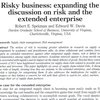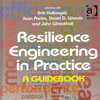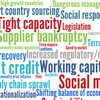 My previous post was part three of a series based on the Swedish business continuity handbook titled “Säkra företagets flöden” and looked at a checklist or questionnaire that can be used in assessing particular disruption risks in your suppliers or sub-contractors. Today’s post will deal with different buyer- supplier relationships and how they can be categorized, and how such relationships may or may not contribute to supply chain disruptions.
My previous post was part three of a series based on the Swedish business continuity handbook titled “Säkra företagets flöden” and looked at a checklist or questionnaire that can be used in assessing particular disruption risks in your suppliers or sub-contractors. Today’s post will deal with different buyer- supplier relationships and how they can be categorized, and how such relationships may or may not contribute to supply chain disruptions.
Procurement and purchasing – an integral part of the supply chain
Procurement or purchasing used to be a specialized “department” within a company, but that is now a thing of the past. Procurement and purchasing are an integral part of the supply chain, it’s no longer just about the logistics of getting supplies to the company and products from the company.
Impact of supply chain disruptions
Very often, the reasons why supply chain disruptions can have such devastating impacts, can be narrowed down to these four reasons:
- The company decided to outsource the production of key components.
- The company sourced key components from a single supplier.
- The company’s production system relied heavily on just-in-time deliveries.
- The company’s supply strategy was based on a purely monetary cost-benefit analysis
Choosing the right strategy is paramount to avoiding supply chain disruptions.
Buyer-supplier releationships
Buyer-supplier relationships have a direction bearing on supply chain disruptions. The closer the relationship, the less likely a disruption is. The following is a list of possible buyer-supplier relationships, in incremental order:
A Discrete purchase
A discrete purchase is the classic relationship between buyer and supplier, based on a price comparison and executed directly or after negotiating. This is the best strategy if the goods or the service purchased is easy and straightforward in its specifications and no maintenance or after sales support is required.
B Simple framework agreement
A simple framework agreement is the lowest level of a business alliance. A framework agreement is an optional agreement, where the buyer can, but not must, buy a certain quantity from a certain supplier within a given time frame, e.g. one year. Normally, a simple framework agreement does not have any contractual bindings as to purchase price, volume discounts, etc., which is separately settled at every purchase.
C Complex framework agreement
A complex framework agreement is one step up from the simple framework agreement. Here, purchase volumes, discounts are usually settled in advance, although there is still no requirement that a purchase must be made. A complex framework agreement is usually preferred over a simple framework agreement is there is little reason to switch suppliers after the contract term, whereas a simple framework agreement is preferred if there are many possible suppliers.
D Business partnership
A business partnership is an agreement of cooperation. Both parties operate as separate businesses, but may choose to cooperate in certain business areas.
E Strategic business partnership
A strategic business partnership is a business partnership that includes research and development (R&D) activities. A strategic business partnership involves trust, and unlike the simple business partnership, also involves openness about strategies and desired development and change.
F Integrated teams
The partnership or alliance can be more specific and dedicated to certain tasks or projects, where teams from both partners work together as one.
G Joint venture
In a joint venture both parties share risk and reward alike. Often this kind of cooperation is used when there is a need for a larger organization to accomplish a certain task, for which each party by itself is too small.
H Vertical ownership
A full integration of all parts of the supply chain is usually termed vertical ownership. This can be advantageous, but does have its drawbacks, in terms of less freedom of choice, potentially less cost-effectiveness etc.
Many relationships
In today’s business world it’s hard to say which buyer-supplier relationship which is best. Vertical ownership may allow for a full restructuring of the supply chain. On the other hand, vertical cooperation is less risky and has the same advantages as vertical ownership. Alliances between vertically cooperating businesses may work juts as well, or even better, than full ownership.
External versus internal supplier
An external (non-integrated) supplier is dependent on the buyer being satisfied for the relationship to continue, and may put in the extra effort that an internal (integrated) supplier may not feel obliged to, since an internal supplier that fails is more likely to be given a second chance than an external supplier.
Full or partial integration
In a partial integration the supplier is vertically integrated, but still open towards other buyers. This way market demand can be used to level out demand fluctuations from the mother company, and at the same time, market demand can be used to further develop and enhance products, since the supplier has to satisfy both the internal and external buyers.
External and internal
A company may often choose to have one vertically integrated supplier for steady, non-fluctuating demand, and use a second, non-integrated supplier to fill in the gaps. However, this is seldom then best bedrock for the external supplier’s performance, because the relationship is maybe too uncertain in a long-term perspective.
Having the right number of the right relationships
Most companies have a large number of suppliers and various relationships with these. Having the right mix and the right number is essential. Less suppliers means less administrative costs. Cutting down on type A or B is easy. Reducing C or D need some consideration. E, F, G and H are strategic decisions and should not be made simply as a cost-reducing measure.
Reference
Giertz, E., et al. (1999) Säkra företagets flöden, Silfgruppen, Stockholm. ISBN 91 7097 056-4
Related
- husdal.com: How to secure your supply chain – 1/7
- husdal.com: How to secure your supply chain – 2/7
- husdal.com: How to secure your supply chain – 3/7
- husdal.com: How to secure your supply chain – 4/7
- husdal.com: How to secure your supply chain – 5/7
- husdal.com: How to secure your supply chain – 6/7
- husdal.com: How to secure your supply chain – 7/7












